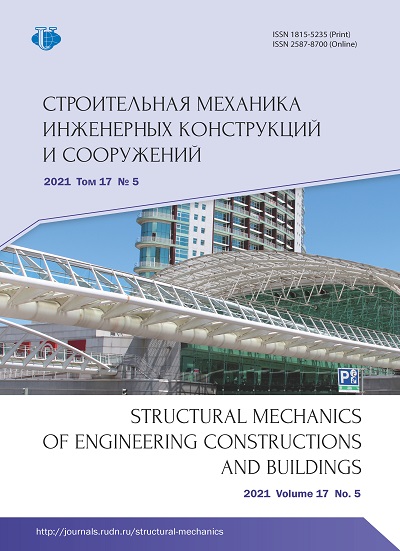Термическая обработка свежего бетона инфракрасным излучением
- Авторы: Свинцов А.П.1, Сиссе А.1
-
Учреждения:
- Российский университет дружбы народов
- Выпуск: Том 17, № 5 (2021)
- Страницы: 528-537
- Раздел: Экспериментальные исследования
- URL: https://journal-vniispk.ru/1815-5235/article/view/325706
- DOI: https://doi.org/10.22363/1815-5235-2021-17-5-528-537
- ID: 325706
Цитировать
Полный текст
Аннотация
В настоящее время все большую актуальность приобретает строительство зданий из монолитного бетона и железобетона. Применение инновационных технологий, минимальные сроки строительства, долговечность, надежность, возможность выполнения работ в различных климатических условиях, архитектурная индивидуальность способствуют развитию монолитного строительства. Бетон и железобетон являются основными материалами современного строительства. Качество конструкций зависит не только от состава бетона, количества портландцемента, применяемых химических добавок, водоцементного отношения, качества наполнителей и др., но и существенным образом от тепловлажностного режима выдерживания бетона. Для обеспечения необходимых температурных условий твердения и набора прочности бетона используют различные методы прогрева конструкций. Одним из них является тепловая обработка в период твердения и приобретения критической или проектной прочности. Цель исследования - совершенствование технологии возведения монолитных бетонных и железобетонных конструкций с использованием тепловой обработки бетона посредством инфракрасного излучения. Разработана технология тепловой обработки уложенной и уплотненной бетонной смеси с использованием инфракрасного обогрева и двухкамерного прозрачного для инфракрасных лучей укрытия. Полученные результаты обеспечивают условия для нормального протекания химической реакции гидратации, твердения и набора прочности, что позволяет успешно решать задачи бетонирования при возведении зданий и сооружений из монолитного бетона и железобетона.
Ключевые слова
Об авторах
Александр Петрович Свинцов
Российский университет дружбы народов
Автор, ответственный за переписку.
Email: svintsovap@rambler.ru
ORCID iD: 0000-0003-0564-3307
доктор технических наук, профессор департамента строительства, Инженерная академия
Российская Федерация, 117198, Москва, ул. Миклухо-Маклая, д. 6Алиму Сиссе
Российский университет дружбы народов
Email: cisserudn88@gmail.com
аспирант департамента строительства, Инженерная академия Российская Федерация, 117198, Москва, ул. Миклухо-Маклая, д. 6
Список литературы
- Rizzuto J.P., Kamal M., Elsayad H., Bashandy A., Etman Z., … Shaaban I.G. Effect of self-curing admixture on concrete properties in hot climate conditions. Constr. Build. Mater. 2020;261:119933. https://doi.org/10.1016/j.conbuildmat.2020.119933
- Bella N., Bella I.A., Asroun A. A review of hot climate concreting, and the appropriate procedures for ordinary jobsites in developing countries. MATEC Web of Conferences. 2017;120:02024. https://doi.org/10.1051/matecconf/201712002024 ASCMCES-17
- Un H., Baradan B. The effect of curing temperature and relative humidity on the strength development of portland cement mortar. Scientific Research and Essays. 2011;6(12):2504-2511. https://doi.org/10.5897/SRE11.269
- Pavlov V.V., Krainov D.V., Akhmerova G.M. Influence of electric heating on concrete strength of individual sections of monolithic reinforced concrete multi-span slabs. Bull. Civ. Eng. 2019;6(77):111-113. (In Russ.) https://doi.org/10.23968/19995571-2019-16-5-111-113
- Permyakov M.B., Krasnova T.V., Kurochkina S.O. The use of solar energy to intensify the hardening of concrete. Actual Problems of Modern Science, Technology and Education. 2019;10(2):7-11. (In Russ.)
- Höhlig B., Schröfl C., Hempel S., Noack I., Mechtcherine V., … Roland U. Heat treatment of fresh concrete by radio waves - avoiding delayed ettringite formation. Constr. Build. Mater. 2017;143:580-588. http://doi.org/10.1016/j.conbuildmat.2017.03.111
- Zhorobayev S.S. Concrete humidity control under intensification of concrete hardness of monolithic reinforced concrete constructions. Bull. SRC Constr. 2019;(3(22)):79-84. (In Russ.)
- Boroulya N.I., Krasnova T.A. Issues of ensuring the preservation of concrete mixtures properties in time. Concrete Technology. 2013;(6(83)):8-11. (In Russ.)
- Marchon D., Flatt R.J. Mechanisms of cement hydration. Sci. Tech. Concr. Admixtures. Woodhead; 2016. p. 129-145. https://doi.org/10.1016/B978-0-08-100693-1.00008-4
- Nkinamubanzi P.C., Mantellato S., Flatt R.J. Superplasticizers in practice. Sci. Tech. Concr. Admixtures. Woodhead; 2016. p. 353-377. https://doi.org/10.1016/B978-0-08-100693-1.00016-3
- Stark J., Wicht B. Dauerhaftigkeit von Beton. Springer: Berlin Heidelberg; 2013.
- Svintsov A.P., Nikolenko Y.V., Kurilkin V.V. Heat treatment of concrete mix in cast-in-situ structures. Industrial Civ. Eng. 2015;1:15-19 (In Russ.)
- Abeka H., Agyeman S., Adom-Asamoah M. Thermal effect of mass concrete structures in the tropics: experimental, modelling and parametric studies. Cogent Engineering. 2017;4(1):1278297. https://doi.org/10.1080/23311916.2016.1278297
- De Schutter G., Yuan Y., Liu X., Jiang W. Degree of hydration-based creep modeling of concrete with blended binders: from concept to real applications. Journal of Sustainable Cement-Based Materials. 2014;4(1):1-14. https://doi.org/10.1080/21650373.2014.928808
- Lawrence A.M., Tia M., Ferraro C., Bergin M. Effect of early age strength on cracking in mass concrete containing different supplementary cementitious materials: experimental and finite-element investigation. Journal of Materials in Civil Engineering. 2012;24:362-372. http://doi.org/10.1061/(ASCE)MT.1943-5533.0000389
- Chuc N.T., Thoan P.V., Kiet B.A. The effects of insulation thickness on temperature field and evaluating cracking in the mass. Concrete Electronic Journal of Structural Engineering 2018;18(2):128-132.
- Xu Y., Xu Q., Chen S., Li X. Self-restraint thermal stress in early-age concrete samples and its evaluation. Construction and Building Materials. 2017;134:104-115. https://doi.org/10.1016/j.conbuildmat.2016.12.066
- Ding H., Zhang L., Zhang P., Zhu Q. Thermal and stress analysis of early age concrete for spread footing. Transactions of Tianjin University. 2015;21(6):477-483. https://doi.org/10.1007/s12209-015-2563-0
- Barbara K., Maciej B., Maciej P., Aneta Z. Analysis of cracking risk in early age mass concrete with different aggregate types. Procedia Engineering. 2017;193:234-241. https://doi.org/10.1016/j.proeng.2017.06.209
- Aniskin N.A., Chuc N.T., Bryansky I.A., Hung D.H. Determination of the temperature field and thermal stress state of the massive of stacked concrete by finite element method. Vestnik MGSU. 2018;13(11):1407-1418. (In Russ.) https://doi.org/10.22227/1997-0935.2018.11.1407-1418
- Havlásek P., Šmilauer V., Hájková K., Baquerizo L. Thermo-mechanical simulations of early-age concrete cracking with durability predictions. Mater. Sci. Eng. 2017;236:32-40.
- Lam T.V., Chuc N.T., Bulgakov B.I., Anh P.N. Composition calculation and cracking estimation of concrete at early ages. Magazine of Civil Engineering. 2018;6:136-148. https://doi.org/10.18720/MCE.82.13
- Podgornov N.I. Heat treatment of concrete with use of solar energy. Moscow: ASV Publ.; 2010. (In Russ.)
- Koroteev D.D., Harun M. Influence of construction of transparent covering on efficiency of concrete heat treatment in shuttering forms with using solar energy. Structural Mechanics of Engineering Constructions and Buildings. 2018; 14(1):64-69. (In Russ.) https://doi.org/10.22363/1815-5235-2018-14-1-64-69
Дополнительные файлы









